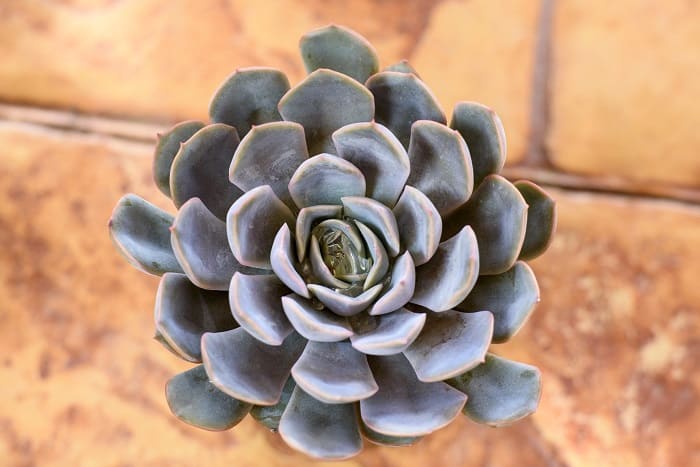Succulents plants are easy to love, cultivate and care for, which makes them an excellent plant for anyone to have.
The echeveria orion is a thriving specimen that can survive long periods of time without water and nutrients.
All these plants come from the Americas. Most are from Mexico; However, there are some species that come from Central and South America.
Echeveria’ orion’ ‘is a great hybrid between Echeveria Iflocum and Echeverria puffcorns, it’s a succulent with beautiful colors.
This is an Echeveria that can measure up to 20 cm in diameter. The leaves are greyish-green with greyish-red margins and tips and a compact habit.
Echeveria orion care tips
Follow the next steps, and you will enjoy a thriving succulent you can have it indoors or outdoors. This plant is a survival succulent that you won’t regret caring for.
Watering
When watering the echeveria orion water with abundance, especially if it’s outdoors, in a rockery set or garden.
If the succulent is planted in a pot, you must be careful with excess watering to avoid rottenness.
Moderate watering during the summer (2 times a week) and zero or almost zero in winter (once a month). And remember to water on the substrate and not on the leaves.
A general rule that can help you avoid over-watering your succulents is to make sure to only water when the soil is dry.
And always avoid wetting the leaves. Never spray water on the plant.
One technique to take into account, as the plant is very compact and quickly occupies the pot, is watering by immersion.
You can do it by immersing the pot in water so that the soil absorbs the necessary moisture.
Temperature
This species is native to arid climates. It needs high temperatures 28°C throughout the year, although it can handle periods of low temperatures between 15°C and 25° C.
But it won’t tolerate frost.
Substratum
For the substrate, use a mixture of 1/3 sand and 2/3 leaf mulch.
If you want to grow this species in pots, these should always be wide and shallow.
This species has small roots and multiplies vegetatively around it. But it can cover the entire pot over time.
Transplant
How to transplant echeveria orion?
Like all plants, if the roots have occupied all the available space in the pot. It must be transplanted periodically in spring.
Use a specific compost for cacti, to which you will add coarse river sand or perlite, in a one-to-one ratio, as they make the substrate more porous, facilitating the drainage of irrigation water.
The drain hole should not be clogged by dirt or roots; you can use rocks in the button of the pot to avoid this.
It’s recomend to use terracotta pots and avoid plastic since the teracotta allows the soil to perspire.
Try using a wide pot rember the roots for this plants grow wide not deep.
Plagues and diseases
There are no known serious diseases associated with this species. Pests are a problem. It is attacked by slugs and snails that feed on the entire plant.
It is also attacked by aphids or mealybugs that feed on its leaves until they dry.
To eliminate these pests, it’s best to locate the plant where slugs and snails do not reach, and in case of being parasitized by mealybugs, we can eliminate them by washing the leaves with a cotton swab moistened with alcohol.
Pruning
This is not required; what you can do is remove the wilted or diseased leaves to maintain the beauty and health of your echeveria ‘orion’.
Very easy by cutting stems over 5 cm long. They usually take root very quickly if we plant them in a sandy and humid substrate.
Propagation
How to propagate your succulent by cuttings?
The leaves should be torn off by pulling horizontally so that the tear is clean. There should be no remains of the stem on the torn leaf.
Now we leave the leaves in a dry place so that the cutting area dries up. Depending on where we live, this will take between a couple of days to a week.
By letting the cut dry, we prevent the leaf or the cutting from absorbing too much moisture when planted.
We will place the leaves on a bed of moist substrate. We will leave the container in a place where it receives a lot of sunlight but in an indirect way.
After a few weeks, we will see how a seedling emerges from the cutting area of the leaves. We will let it develop, and then we can plant them in a pot.
The mother leaf can be separated manually or wait for it to be released from the seedling.
We will spray a little water on the cut areas of the plants every day.
We can also cut the upper part of our donor succulents and do the same as we have done with the leaves. Let the cutting dry and plant it in a new substrate.
The trunk that we leave will sprout again, which we will also use to form new plants.
Illumination
The echeveria ‘orion’, needs a lot of light in all seasons of the year.
Although during summers is essential to protect them from long periods of time in direct sunlight.
For this plant, it’s recommended, if possible, to have it indoors close to a window.
Fertilizer
It’s recommended to fertilize during summer every 15 to 20 days with a liquid fertilizer diluted in water.
Always follow the product user guide.
You might like to use a 15-15-15 fertilizer for this succulents.
